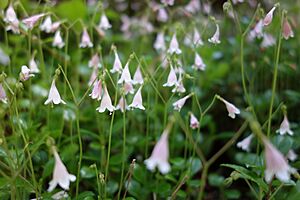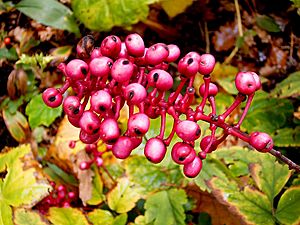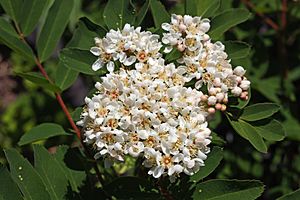Verna Pratt flowers facts for kids
Verna Pratt spent her life studying the amazing wildflowers and plants of Alaska. She helped start the Alaska Native Plant Society (AKNPS) and was its first president. Verna also wrote books about the wild flowers and berries she found in Alaska. Her work helped many people learn about the beautiful plants of this northern land.
Contents
Discovering Alaska's Wild Plants
Twin Flower
The Twin Flower is a delicate plant that belongs to the honeysuckle family. Its scientific name, Linnaea Borealis, means "northern." A famous Swedish plant expert, Carl Linnaeus, named this flower in 1753. He named it after a close friend and teacher because it was his favorite plant.
Where it Grows
You can find Twin Flowers in forests and dry areas, even on mountains. They usually bloom from mid-June to early August. This flower grows not only in Alaska but also in northern Europe, Asia, and parts of North America. Sadly, the number of Twin Flowers has dropped by 50% since 1970, making them a plant to protect.
What it Looks Like
The Twin Flower has long stems with rounded, light green leaves that stay green all year. These leaves grow opposite each other on the stems. The flowering stems have one or two sets of leaves. They carry pink or white bell-shaped flowers on Y-shaped stalks. The flowers grow in pairs, which is why it's called the "Twin Flower." They have a strong smell that lasts for about seven days after they open.
Baneberry or Snakeberry
The Baneberry, also known as Snakeberry, is part of the crowfoot family. There are two types: one has bright red berries, and the other has white berries.
Where it Grows
This plant likes cool, damp forests. You can find it in North America, especially in Alaska and the Yukon. It also grows in some native areas in the North. In Alaska, you might see these plants along mountainsides or next to highways.
What it Looks Like
Baneberry plants are quite tall, growing about 18 to 30 inches high. They have three to five toothed leaves that grow from the flower stalk. The red or white berries grow high above the leaves. They ripen a few weeks after the flowers bloom, usually from mid-July through August.
Safety First
It's very important to know that the berries of the Baneberry plant are very poisonous. Even eating a few berries can be dangerous for a child. Always be careful and never eat wild berries unless an adult who knows them well says they are safe.
Mountain Ash
The Mountain Ash is a native plant that belongs to the Rose family. It usually grows to be 4 to 9 feet tall. Sometimes, you might find a rare, small tree version that can reach up to 20 feet.
Where it Grows
This plant grows in forests, low alpine meadows, and on high mountain slopes. It's common in southeast Alaska and the coastal Southcentral region.
What it Looks Like
The twigs of the Mountain Ash have small brown hairs. Its leaves are divided into 7 to 11 small, notched leaflets. The flowers have five petals and grow in round, flat clusters at the ends of the branches. These flowers produce large, red or orange berries that ripen in the fall. The berries are safe to eat, but they taste bitter until they have been frozen and thawed a few times.
Reproduction and Life Cycle
The Mountain Ash plant grows from seeds. Once the plant is about 15 years old, it starts making seeds every year. Birds like the bohemian waxwing eat the berries and help spread the seeds. The seeds are tough, but deer sometimes damage them.




